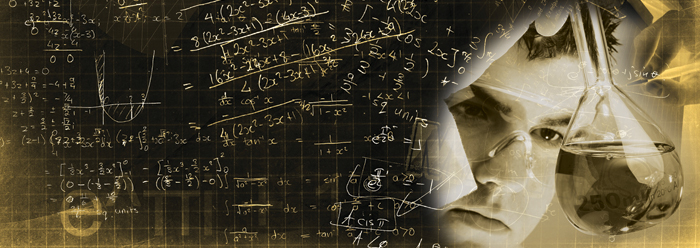In this day of iPods, cell phones, the Internet, and other fruits of modern science and technology, most people have at least a passing awareness of the concept of the scientific method. But just what is this process that undergirds such spectacular technological advance and development? If it can give us satellites showing the world's weather in real time, is it possible for this method, under certain circumstances, to fail?
The Method Defined
Frank Wolfs, Professor of Physics at the University of Rochester, provides his undergraduate physics students with a good working definition of the scientific method: "the process by which scientists, collectively and over time, endeavor to construct an accurate (that is, reliable, consistent and non-arbitrary) representation of the world."1
Professor Wolfs, as a research scientist himself, points out some of its limitations: "Recognizing that personal and cultural beliefs influence both our perceptions and our interpretations of natural phenomena, we aim through the use of standard procedures and criteria to minimize those influences when developing a theory. As a famous scientist once said, 'Smart people (like smart lawyers) can come up with very good explanations for mistaken points of view.' In summary, the scientific method attempts to minimize the influence of bias or prejudice in the experimenter when testing a hypothesis or a theory."1
Four Essentials of the Scientific Method
Just what are these "standard procedures and criteria" that scientists apply in their attempt to arrive at an accurate and reliable representation of the world in which we live? Most scientists, including Wolfs, boil them down to the four following essentials:1
- Observation and description of a phenomenon or group of phenomena.
- Formulation of a hypothesis to explain the phenomena. (In physics, the hypothesis often takes the form of a mathematical relationship.)
- Use of the hypothesis to predict other phenomena or to predict quantitatively the results of new observations.
- Performance of experimental tests of the predictions by several independent experimenters.
If the experiments bear out the hypothesis, it may come to be regarded as a theory or law of nature. If they do not, the hypothesis must be rejected or modified. As Wolfs explains, "No matter how elegant a theory is, its predictions must agree with experimental results if we are to believe that it is a valid description of nature. In physics, as in every experimental science, 'experiment is supreme' and experimental verification of hypothetical predictions is absolutely necessary."1
Wolfs further notes that this necessity of experiment in the method is tantamount to requiring that a scientific hypothesis be testable. "Theories which cannot be tested, because, for instance, they have no observable ramifications (such as, a particle whose characteristics make it unobservable), do not qualify as scientific theories."1 It is fairly obvious that if a hypothesis cannot be tested, it should more properly be called a conjecture or speculation, in which case the scientific method can say little about it.
When Does the Scientific Method Fail?
Are there circumstances in which the scientific method ought to work, but for which the method does not provide "an accurate representation of the world"--that is, a correct description of the way things really are? Unfortunately, the answer is yes. As Professor Wolfs mentions above, "personal and cultural beliefs influence both our perceptions and our interpretations of natural phenomena." If the hypothesis-testing process fails to eliminate most of the personal and cultural biases of the community of investigators, false hypotheses can survive the testing process and then be accepted as correct descriptions of the way the world works. This has happened in the past, and it happens today.
Some of the most glaring examples of this failure of the scientific method today have to do with the issue of origins. There are two fairly obvious reasons for this: 1) many of the crucial processes occurred in the past and are difficult to test in the present; and 2) personal biases are especially strong on topics related to origins because of the wider implications.
Skipping the Test
Perhaps the most prominent example in this category is the hypothesis that mutation and natural selection produce continuous genetic improvement in a population of higher plants or animals. For the past 90 years, scientists in the field of population genetics have developed sophisticated mathematical models to describe and investigate these processes and how they affect the genetic makeup of populations of various categories of organisms. The work of R. A. Fisher, J. B. S. Haldane, and Sewall Wright between 1918 and 1932 laid the foundation for the field of population genetics. This work in turn, over a period of about a decade (1936-1947), led to the formulation of what is referred to as the neo-Darwinian synthesis or the modern evolutionary synthesis. This so-called modern synthesis integrated the concept of natural selection with Mendelian genetics to produce the unified theory of evolution that has been accepted by most professional biologists.
But does this theory of evolution, formulated essentially in its present form more than 60 years ago, truly deliver on its claims, especially in light of what we now know of how living systems work at the molecular level? The answer is an unequivocal no! In brief, the proteins that make up living systems require such a precise level of specification to be functional that a search based on random mutation can never succeed.2 It is complete scientific foolishness to claim otherwise. That is why there are no papers in the professional genetics literature that explicitly demonstrate this to be a reasonable possibility.
Perhaps even more surprising, natural selection does not deliver the sort of upward genetic improvement that is generally believed and claimed.3 The reason is that natural selection is "blind" to the vast majority of mutations--it cannot act upon a favorable mutation to accentuate it or a deleterious mutation to eliminate it unless the mutation has a sufficiently large effect on the fitness of the organism in its environment. Because the vast majority of mutations are below the threshold for natural selection to detect, most bad mutations accumulate unhindered by the selection process, resulting in a downward decline in fitness from one generation to the next.4,5 Because bad mutations outnumber favorable ones by such a large factor, their cumulative effect utterly overwhelms that of the few favorable mutations that may arise along the way.
For more than 30 years, professional population geneticists have been aware of the profound difficulties these realities present to the theory of evolution.6,7 These problems were treated as "trade secrets" to be researched within their own ranks but not to be publicized outside in the broader biology community. Thus, the crucial step of hypothesis testing has been "postponed."
Most professional biologists have therefore been misled into believing that the theoretical foundation of the neo-Darwinian synthesis is secure when, in reality, the foundation is a sham. The neo-Darwinian mechanism can readily be shown to produce exactly the opposite consequences to those that are believed and claimed.3,4,5 The reason for this state of affairs is that the scientists involved have allowed their personal biases to interfere with and to shortcircuit the usual hypothesis-testing step of the scientific method.
Geology and Cosmology
A similar state of affairs persists in the geological community, which interprets the primary sedimentary units of most of the fossil-bearing part of the geological record as having been produced by gradualistic rather than catastrophic processes, when the evidence is abundantly in favor of the latter.8
Likewise, in cosmology, to avoid the inference that the earth is near the center of the cosmos, as implied by isotropy of redshift and of cosmic microwave background energy, a highly speculative and difficult-to-test hypothesis has been invoked--namely, the Copernican Principle,9 which posits that the entire cosmos is just like what we observe from the earth, at least at large scales. A result is that gravity perfectly cancels at large scales and keeps the cosmos from being inside a black hole during the early phases of a Big Bang. All Big Bang models depend critically on this hypothesis. The fact that the Copernican Principle up to now has been untestable means, strictly speaking, that Big Bang cosmology cannot be viewed as authentic science since it relies in a critical way on an untestable hypothesis.
Conclusion
In summary, science is a social enterprise. Scientists are human and share the same weaknesses as all members of the human race. The scientific method fails to yield an accurate representation of the world, not because of the method, but because of those who are attempting to apply it. The method fails when scientists themselves, usually collectively, allow their own biases and personal preferences to shortcircuit the hypothesis-testing part of the process.
References
- Wolfs, F. 1996. Introduction to the scientific method. Physics Laboratory Experiments, Appendix E, Department of Physics and Astronomy, University of Rochester.
- Baumgardner, J. 2008 (in press). Language, Complexity, and Design. In Seckback, J. and R. Gordon (eds.), God, Science and Intelligent Design. Singapore: World Scientific.
- Sanford, J. 2005. Genetic Entropy and the Mystery of the Genome. Lima, NY: Elim Publications.
- Sanford, J., J. Baumgardner, et al. 2007. Using computer simulation to understand mutation accumulation dynamics and genetic load. In Shi, Y. et al. (eds.), ICCS 2007, Part II, Lecture Notes in Computer Science, Vol. 4488. Berlin and Heidelberg: Springer-Verlag, 386-392.
- Sanford, J., J. Baumgardner, et al. 2008 (in press). Numerical simulation falsifies evolutionary genetic theory. Proceedings of the Sixth International Conference on Creationism. San Diego, CA: ICR.
- Kimura, M. 1979. Model of effectively neutral mutations in which selective constraint is incorporated. Proceedings of the National Academy of Sciences. 76: 3440-3444.
- Kondrashov, A. S. 1995. Contamination of the genome by very slightly deleterious mutations: why have we not died 100 times over? Journal of Theoretical Biology. 175: 583-594.
- Austin, S. A. 1994. Grand Canyon: Monument to Catastrophe. Santee, CA: ICR.
- Hawking, S. W. and G. F. R. Ellis. 1973. The Large Scale Structure of Space-Time. Cambridge: Cambridge University Press, 134.
* Dr. Baumgardner is Associate Professor of Geophysics at the ICR Graduate School.
Cite this article: Baumgardner, J. 2008. Exploring the Limitations of the Scientific Method. Acts & Facts. 37 (3): 4.







